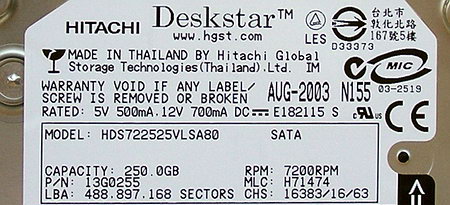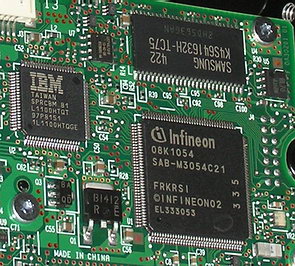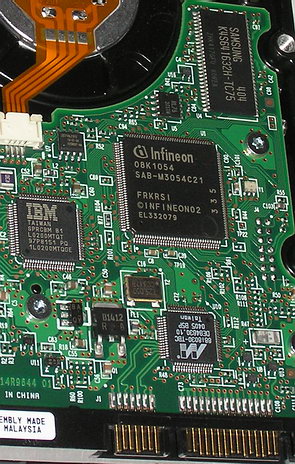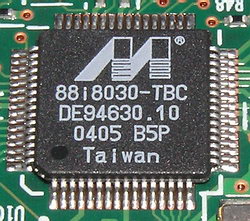
| « | » |
Hitachi Deskstar 7K400 hard disks cannot be reviewed out of context of their direct predecessors — Hitachi Deskstar 7K250 and IBM Deskstar 180GXP. Besides, having reviewed in 2004 the Serial ATA and UltraATA Deskstar 7K250 models of average capacity (see the corresponding reviews at the provided links), we still haven't tested the senior 250 GB SerialATA model of the Deskstar 7K250 (Vancouver 3) series — HDS722525VLSA80. This model is also very interesting in itself — as a forerunner of Deskstar 7K400 (Kurofune) in particular. That's why the HDS722525VLSA80 model will also feature in our today's review, together with the HDS724040KLSA80 and HDS724040KLAT80 models of the Deskstar 7K400 series with serial and parallel interfaces correspondingly, which were released a year later.


The main rated characteristics of Hitachi hard disks of Deskstar 7K400, 7K250 and 180GXP series are presented in Table 1.
| Series | Deskstar | ||
|
|
|
|
|
| Capacity, GB |
|
|
|
| Number of heads/platters |
|
|
|
| Data density, GB per platter (Gbit/inch2) |
|
|
|
| Media transfer rate (max. Mbits/sec) |
|
|
|
| Sustained data rate (MB/sec) |
(zone 0-29) |
(zone 0-30) |
(zone 0-27) |
| Seek time average, ms |
|
|
|
| Logical interface |
|
|
|
| Physical interface |
|
|
|
| Interface transfer rate (MB/sec) |
|
|
|
| Data buffer (MB) |
|
|
|
| Buffer area for drive firmware (KB) |
|
|
|
| Start/stops |
|
|
|
| Idle acoustic noise (dBA) |
|
28 (2 disks) 26 (1 disk) |
28 (2 disks) 26 (1 disk) |
| Seek acoustic noise (dBA) |
|
|
|
| Operating shock resistance (2ms), G |
|
|
|
| Non-operating shock resistance (2ms), G |
|
350 (1 and 2 platters) |
300 (3 platters) |
| Temperature, C, on(off) |
|
||
| Max power consumption (W) at startup and idle |
30 (2A@12V) 9(pata)/ 9.6(sata) |
5-7(pata)/ 5.6-7.6(sata) — depending on the number of platters |
5.0-7.0 — depending on the number of platters |
| Max weight (g) |
|
|
|
One can notice that 7K400 and 7K250 series drives use practically the same 80 GB platters (probably formatted slightly differently) with the data density of 62 Gbit per inch2 and the same max and min read-write speed. Five platters and ten heads in Kurofune hard disks didn't deteriorate their rated access time — the same average 8.5 ms as in the 7K250 and 180GXP series. The other characteristics also remained the same as in 7K250, except for the acoustic noise, shock resistance, power consumption, and weight. But if the inevitable "deterioration" of Kurofune in comparison with Vancouver 3 in acoustics, weight, and the buffer area taken by firmware cannot be called considerable, the "novices" lost noticeably more in power consumption and shock resistance compared to the "old guys". The power consumption increased at least by 2 Watts (in comparison with the senior 7K250 models; by the way, power consumption specified on top of the hard disks do not always coincide with those marked in the specifications on the official web site), so Kurofune may require additional cooling (over 10 W in operating mode — that's not a laughing matter) and the non-operating shock resistance at 225G was characteristic of desktop hard disks four years ago. Fortunately, operating shock resistance of the new hard disks did not become worse.
Deskstar 7K400 series consists of only two models — 400 GB each, with serial and parallel interfaces. Less capacious Hitachi Deskstar models still pertain to the 7K250 series. However, very soon Hitachi is to announce a new series of its desktop hard disks, where everything may be noticeably different. It's hard to tell when these disks will appear on sale though, so consumers will have content themselves with the 7K400 and 7K250 for a long time.
The only difference between the two models of the 7K400 series is actually different interfaces — UltraATA/133 and Serial ATA (see Table 2).
| Deskstar 7K400 models | HDS724040KLAT80 | HDS724040KLSA80 |
| Interface |
|
|
| Capacity, GB1 |
|
|
| Number of heads and platters |
|
|
| Data buffer, MB2 |
|
|
| Spindle rotational speed, rpm |
|
|
| Media transfer rate (max. Mbits/sec) |
|
|
| Interface transfer rate (max. MB/sec) |
|
|
| Sustained data rate (MB/sec) |
|
|
| Seek time average, (read, typical (MS)) |
|
|
| Reliability | ||
| Error rate (non-recoverable) |
|
|
| Start/stops (at 40° C) |
|
|
| Acoustic | ||
| Idle (Bels) |
|
|
| Power | ||
| Requirement |
|
|
| Dissipation | ||
| Startup current (max. A) |
|
|
| Idle (W) |
|
|
| Physical size | ||
| Height (mm) |
|
|
| Width (mm) |
|
|
| Depth (mm) |
|
|
| Weight (max. g) |
|
|
| Environmental characteristics | ||
| Operating | ||
| Ambient temperature |
|
|
| Relative humidity (non-condensing) |
|
|
| Shock (half sine wave, 2ms) |
|
|
| Vibration (random (RMS) |
|
|
| Non-operating | ||
| Ambient temperature |
|
|
| Relative humidity (non-condensing) |
|
|
| Shock (half sine wave, 2ms) |
|
|
| Vibration (random (RMS) |
|
|
1 GB equals one billion bytes when referring to hard drive capacity; accessible capacity may be less.
2 Buffer capacity includes 271 KB used for drive firmware.
Note that while the 7K250 is announced to have ATA-7 and UltraATA/100 interfaces at 100 MB/sec (180GXP uses ATA-6 at the same speed), the 7K400 features the same ATA-7 but already with UltraATA/133 (which is honestly reported by utilities, demonstrating maximum UDMA-6 mode for SATA/UATA 7K400 models and maximum UDMA-5 mode for SATA/UATA 7K250 models), though according to the specification its transfer rate is still 100 MB/sec instead of 133 MB/sec as appropriate to a true UltraATA/133 (UDMA-6). However, direct measurements demonstrate that the interface data rate in UATA 7K400 disk can really be faster than 100 MB/sec, that is UltraATA/133 is not an idle declaration but a physical reality. It's just that the official on-site specification contains an error.
Besides, interface differences between the 7K400 models result in increased power consumption of the SATA model — approximately half a watt higher, as well as in the 7K250 series.
Unfortunately, 7K400 and 7K250 series Serial ATA 1.0 models lack the fashionable Native Command Queuing (NCQ) support — NCQ support will appear only in Hitachi hard disks of the next generation, which should be announced in January 2005. (After this review had been already written, Hitachi announced its new desktop hard disks Deskstar 7K500 and Deskstar T7K250 supporting SATA II, see the news.) Serial ATA interface is still organized here (as in the 7K250) using "the time-proven" scheme with a parallel interface controller (this one is based on the Infineon 08K 1054 SAB-M3054C21 chip, see the photo)


and a bridge, which translates the parallel interface into the serial, based on the "super-popular" (in the recent past) Marvell 88i8030 chip.

By the way, the 7K250 series hard disks (the SATA model HDS722525VLSA80 under review in particular) uses the same parallel interface controller — Infineon 08K 1054 SAB-M3054C21. Though as we have already noted above, according to the specifications and data utilities the maximum speed mode of hard disk controllers is different in the 7K400 and 7K250 series: UDMA 6 (ATA-133) for the former and UDMA 5 (ATA-100) for the latter (Marvell chip supports up to UDMA 6).
| « | » |